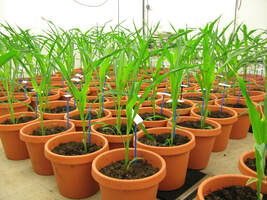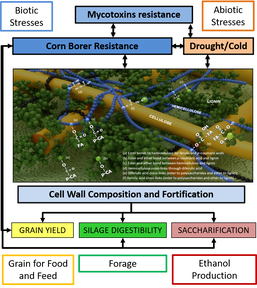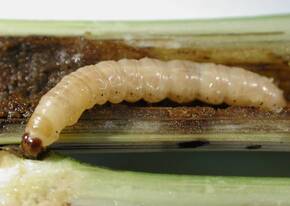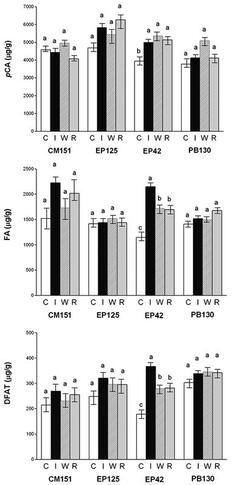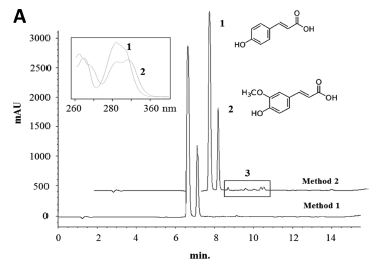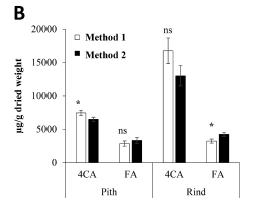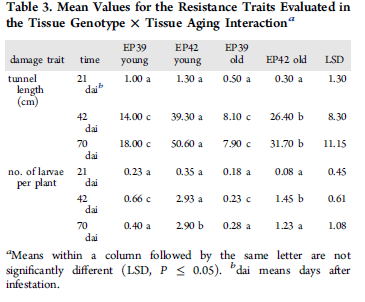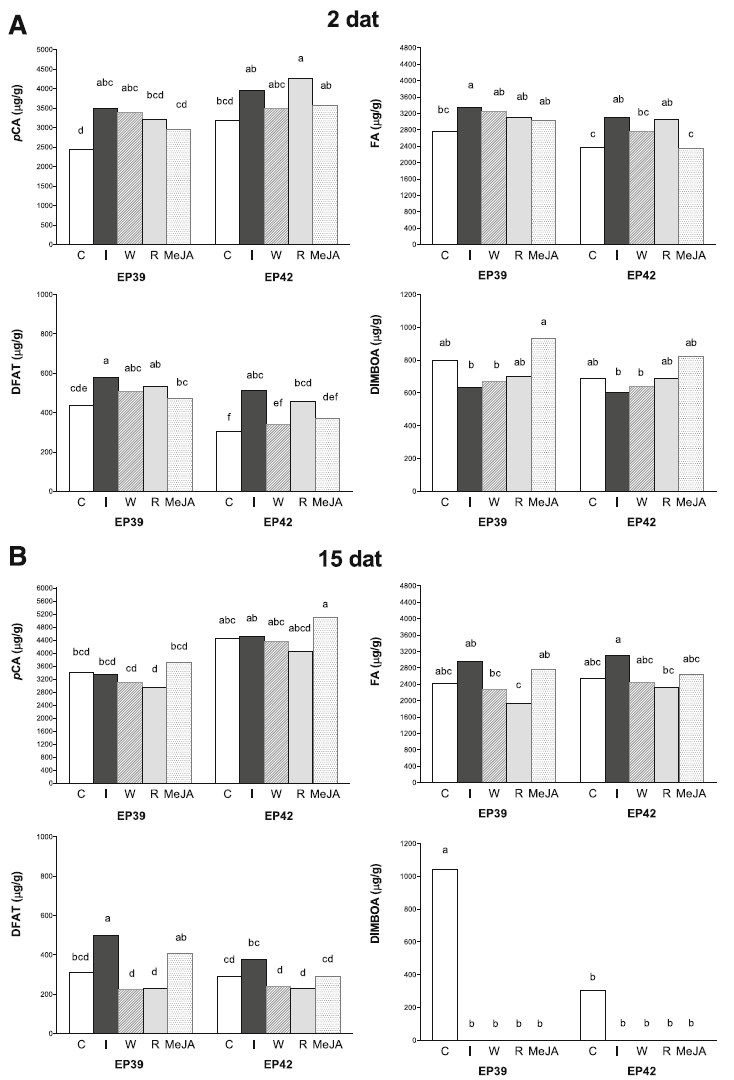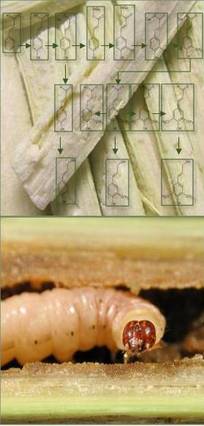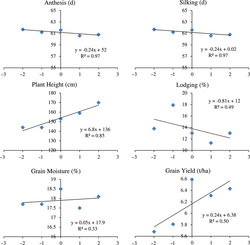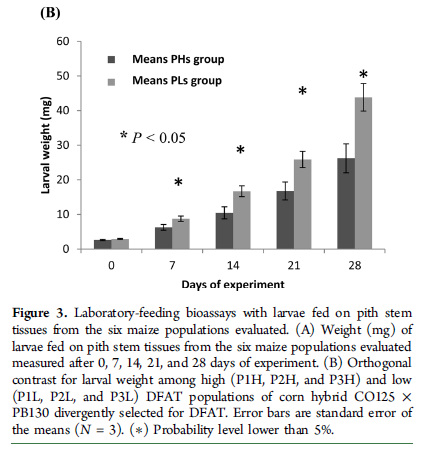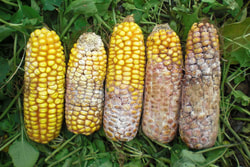Plant Defense against Biotic Stresses
Environmental Agriobiology, Plant and Soil Quality (University of Vigo),
Associated Unit to Misión Biologica de Galicia (Spanish National Research Council)
Associated Unit to Misión Biologica de Galicia (Spanish National Research Council)
About us
We are a multidisciplinary research teamwork interested in plant biochemical and structural mechanisms involved in the interactions with herbivorous insects and fungal pathogens. Our teamwork is a collaboration between the Plant and Soil Science group of University of Vigo and the Misión Biológica de Galicia (CSIC).
We focus on maize cell wall composition (structural phenolics, hemicellulose, cellulose and lignin) and their involvement in plant resistance against corn borers feeding (Sesamia and Ostrinia) and fungal infections by Fusarium species. Besides the biochemical approach, we also apply a genetic approach to identify genomic regions (QTLs) and genes related to cell wall biosynthesis and plant defense. We have extensive experience in the development of breeding programs, through which we have obtained genetically improved populations and maize inbred lines with interesting agronomic and/or resistance characteristics.
We focus on maize cell wall composition (structural phenolics, hemicellulose, cellulose and lignin) and their involvement in plant resistance against corn borers feeding (Sesamia and Ostrinia) and fungal infections by Fusarium species. Besides the biochemical approach, we also apply a genetic approach to identify genomic regions (QTLs) and genes related to cell wall biosynthesis and plant defense. We have extensive experience in the development of breeding programs, through which we have obtained genetically improved populations and maize inbred lines with interesting agronomic and/or resistance characteristics.
Selected publications
Effect of long-term feeding by borers on the antibiotic properties of corn stems
|
Methods for Determining Cell Wall-Bound Phenolics in Maize Stem Tissues
Rogelio Santiago, Rosa Ana Malvar, Carlos Souto, Jaime Barros-Rios. 2018. Journal of Agricultural and Food Chemistry 66, 1279-1284. Link
We compared two methods with different sample pretreatment, hydrolysis, and separation procedures to extract cell wall-bound phenolics. The samples were pith and rind tissues from six maize inbred lines reportedly containing different levels of cell wall-bound phenolics. In method 1, pretreated samples were extracted with a C18 solid-phase extraction cartridge, and it took 6 days to complete. In method 2, phenolics were extracted from crude samples with ethyl acetate, it took 2 days to complete, and the cost per sample was reduced more than 60%. Both methods extracted more 4-coumarate than ferulate. Overall, method 1 yielded more 4-coumarate, while method 2 yielded more ferulate. The lack of a genotype × method interaction and significant correlations between the results obtained using the two methods indicate that both methods are reliable for use in large-scale plant breeding programs. Method 2, scaled, is proposed for general plant biology research.
|
Chemical Changes during Maize Tissue Aging and Its Relationship with Mediterranean Corn Borer Resistance A. López-Malvar; B. Ordás; C. Souto; A. Encina; R. A. Malvar; R. Santiago. 2017. Journal of Agricultural and Food Chemistry Vol. 65, 9180-9185 The main goals of this study were to determine possible changes in chemical traits (phenols, flavonoids, anthocyanins, sugars, fibers, and lignin) during plant development after the flowering stage and to assess how those traits may differ in diverse genotypes of maize, such as MCB resistant and susceptible. Higher values for some particular traits in more mature tissues seemed to increase their effectiveness against the MCB attack. A decreased amount of borer damage in the field was recorded in the resistant inbred line and in older tissues (7.90 cm vs 31.70 cm as the mean for the stalk tunnel length). In accordance with these results, the resistant inbred line showed a higher degree of hemicellulose cross-linkage (due to ferulic and diferulic acids), higher soluble sugar content, and higher stalk strength. The use of resistant varieties and early sowings is highly recommended as an integrated approach to reduce the yield losses produced by this pest. |
|
Defensive changes in maize leaves induced by feeding of Mediterranean corn borer larvae. Rogelio Santiago, Ana Cao, Ana Butrón, Ana López-Malvar, Víctor M. Rodríguez, Germán V. Sandoya, Rosa A. 2017. BMC Plant Biology 17:44. In this study, we examined the effects of several treatments applied to two maize genotypes (one resistant, one susceptible) on the subsequent growth and survival of Sesamia nonagrioides Lef. (Mediterranean corn borer, MCB) larvae and on concentrations of cell wall-bound hydroxycinnamates and benzoxazinoids. The treatments were infestation with MCB larvae, application of MCB regurgitant upon wounding, wounding alone, or exposure to methyl jasmonate, and they were applied at the V6–V8 stage of maize development. The leaves of plants pre-infested with MCB larvae were less suitable for larval development than those from untreated plants. Application of MCB regurgitant upon wounding, and wounding itself, resulted in leaf tissues becoming less suitable for larval growth than those of pre-infested plants, suggesting that there could be herbivore-associated effector molecules that suppress some wounding responses. A single application of MCB regurgitant did not seem to mimic feeding by MCB larvae, although the results suggested that regurgitant deposited during feeding may have enhanced ferulates and diferulates synthesis in infested vs. control plants. Jasmonic acid may play a role in mediating the maize response to MCB attack, but it did not trigger hydroxycinnamate accumulation in the leaves to a level comparable to that induced by larval leaf feeding. The EP39 maize genotype showed an increase in leaf cell wall strength by increasing hemicellulose cross-linking in response to MCB attack, while induced defenses in the EP42 plants appeared to reflect a broader array of resistance mechanisms. |
|
Hydroxycinnamate Synthesis and Association with Mediterranean Corn Borer Resistance.
Rogelio Santiago, Rosa Ana Malvar, Jaime Barros-Rios, Fernando Samayoa, Ana Butrón. 2016. J. Agric. Food Chem., 2016, 64 (3), pp 539–551. Previous results suggest a relationship between maize hydroxycinnamate concentration in the pith tissues and resistance to stem tunneling by Mediterranean corn borer (MCB, Sesamia nonagrioides Lef.) larvae. This study performs a more precise experiment, mapping an F2 derived from the cross between two inbreds with contrasting levels for hydroxycinnamates EP125 × PB130. We aimed to co-localize genomic regions involved in hydroxycinnamate synthesis and resistance to MCB and to highlight the particular route for each hydroxycinnamate component in relation to the better known phenylpropanoid pathway. Seven quantitative trait loci (QTLs) for p-coumarate, two QTLs for ferulate, and seven QTLs for total diferulates explained 81.7, 26.9, and 57.8% of the genotypic variance, respectively. In relation to borer resistance, alleles for increased hydroxycinnamate content (affecting one or more hydroxycinnamate compounds) could be associated with favorable effects on stem resistance to MCB, particularly the putative role of p-coumarate in borer resistance. |
|
Agronomic performance of maize populations divergently selected for diferulate cross-linkage.
R. Santiago, J. Barros-Ríos, A. Alvarez, R.A. Malvar. 2016. Journal of Agricultural Science, Page 1 of 10. Cambridge University Press doi:10.1017/S0021859615001161 The direct response of a divergent selection programme for total cell wall ester-linked diferulate concentration in maize pith stalk tissues and its indirect effect on cell wall degradability and corn borer resistance have been previously evaluated. Since increased total diferulate concentration is expected to improve crop performance in response to corn borers, the objective of the present research was to evaluate the indirect response of the divergent selection for diferulates on agronomic traits under corn borer infestation. For this purpose, five maize populations with contrasting total diferulate concentrations were evaluated four environments for performance under protected and infested conditions. Measured traits were: days to anthesis, days to silking, plant height, stalk lodging, grain moisture at harvest and grain yield. High diferulate populations showed a significant reduction in anthesis (precocity), and were 11 cm taller than the starting population, while low diferulate populations were 9 cm shorter, and showed nearly 1 t/ha lower grain yield than the original and high diferulate populations. The analysis showed that cycles of selection were positively correlated with flowering, plant height and grain yield. The infestations with borers produced >1 t/ha of reduction in grain yield; although the higher diferulate populations showed a better performance under infestation than the low diferulate populations. This positive effect on the grain yield by increasing diferulate content can be considered an extra in order to breed for resistance to corn borers. |
Fig. 1. Simple linear regression analyses. Values of 2, 1, 0, –1 and –2 represent the maize populations P2H, P1H, P0, P1L and P2L, respectively.
|
|
Covalent Cross-Linking of Cell-Wall Polysaccharides through Esterified Diferulates as a Maize Resistance Mechanism against Corn Borers
Jaime Barros-Rios, Rogelio Santiago, Hans-Joachim G. Jung, and Rosa A. Malvar. J Agr Food Chem 2015, 63:2206-221. Maize populations selected for high total diferulate concentration had 31% higher diferulates than those selected for low diferulates. Stem tunneling by corn borer species was 29% greater in the population with the lowest diferulates than in the population with the highest diferulates (31.7 versus 22.6 cm), whereas total diferulate concentration was negatively correlated with stem tunneling by corn borers. Moreover, orthogonal contrasts between groups of populations evaluated showed that larvae fed in laboratory bioassays on pith stem tissues from maize populations with higher diferulates had 30−40% lower weight than larvae fed on the same tissues from maize populations with lower diferulates. Current findings will help to develop adapted maize varieties with an acceptable level of resistance against borers and be useful in special kinds of agriculture, such as organic farming. |
|
Inheritance of maize resistance to gibberella and fusarium ear rots and kernel contamination with deoxynivalenol and fumonisins
A. Butrón, L. M. Reid, R. Santiago, A. Cao and R. A. Malvar. Plant Pathology 2015, 64: 1053–1060. Although maize genetics involved in resistance to ear rots and mycotoxin contamination greatly depended on the environment, additive and dominance effects were the predominant genetic effects in most environments. The stability across environments for resistance to ear rots and deoxynivalenol and fumonisin contamination was low, and recommended target areas of breeding programmes for either Fusarium species are different based on the different nature of genetic effect x environment interactions for each species. In general, the classification of inbreds and hybrids according to their resistance levels was similar across environments, suggesting that the same sources of resistance could be suitable for different environments, and breeding for resistance to one species would affect resistance to the other one. |
Plant defense against biotic stresses
Environmental Agriobiology, Plant and Soil Quality (University of Vigo), Associated Unit to Misión Biologica de Galicia (CSIC)
Environmental Agriobiology, Plant and Soil Quality (University of Vigo), Associated Unit to Misión Biologica de Galicia (CSIC)



